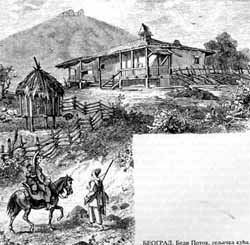Pri tome, Pancic posebno definiše razlicita staništa na sledeci nacin:
1.- "po baštama, oko drumova, po putovima i drumovima";
2.- "po njivama, prelozima"; 3.- "po utrinama, sušnim
livadama"; 4.- "na pesku, po prljužama"; 5.- "po
šumama, u japadu"; 6.- "po kamenjarima, na zidinama"; 7.- "po lukama, na bujnim
livadama"; 8.- "po mlakama, u vodi, na obali od reka i potoka".
Among the localities where, as he says, “the rarities of our flora should
be searched for” of particular interests are Topcider, Košutnjak, and
monastery forest in Rakovica, Bele Vode, Ciganlija, Makiš, Železnik, Ostružnica,
Kajaburma (around ponds), Višnjica, Slanci, Smederevo road, Kaludjerica, Kumodraž,
valey near village Mokri Lug, Banjica and Torlak, Mt Avala etc.
Over the first 10 years of flora’s investigations in the surrounding of Belgrade,
Pancic recorded 1,057 flowering plants, classified into 427 plant genera.
Among them a few are new species to science, such as Thlaspi
avalanum Panc., discovered in Mt Avala. In addition to this species,
which is also today considered as good species in almost all contemporary
floristic works, Pancic recorded in the surrounding of Belgrade Iris
serbica Panc, Rosa belgradensis
Panc., Rosa Vrncensis
Panc., Rosa slancensis
Panc and Triticum virescens
(Panc) Panc. and described them as new to science, but at present they
have different status in botanical literature .
Another 5 editions of “Flora in the Surrounding of Belgrade” were published
in the period by 1892.The sixth edition, published after Pancic’s death, contained
1,156 plant species growing in the surrounding of Belgrade.
Pancic conceived this book to serve as a useful manual from/on nature, intended
primarily for school and student youth, aimed at keeping informing them,
at stimulating their research spirit and at educating them as much as possible
in natural sciences. For this reason it was published as pocket edition, suitable
for field research. Though this work may be considered as Josif Pancic’s specific
textbook, it is of permanent value given that it contains new species, till
that time unknown to science. Besides, it furnished an exceptional basis
for all future investigations of the flora and vegetation of the surrounding
of Belgrade. Currently it is considered as a prime source of information
for comparative investigations of the dynamics of flora and vegetation, particularly
those of endangered plant species and ecosystems.
Most of Pancic’s original herbarium material of Belgrade flora, containing
767 of preserved exsiccates, is in the collection Herbarium Pancicianum,
in the Institute of Botany and Botanical Garden.
